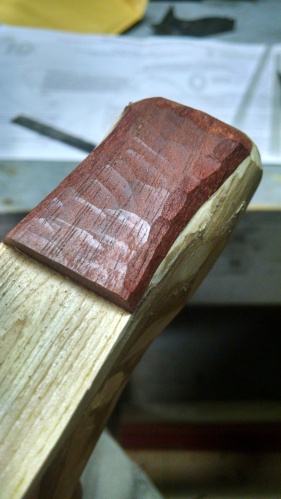It feels a bit strange writing a “how-to” article for a task that I’ve completed exactly once in my life. I would prefer to link to an article written by an expert who’s made fifty of these things, but the internet seems curiously silent on this topic, so here we are.
An elbow adze gets its name from the shape of the handle. Unlike the more familiar western adze, with a straight handle fit into a metal socket, an elbow adze uses branch union for the handle, where the grain naturally follows an elbow shape.


The elbow adze looks like a crude tool, but like any tool, it can be as refined as you make it to be – and even a tool that looks rustic is capable of very fine work if it’s well-made. So what’s the advantage of the elbow adze? More than anything, the advantage is the cost – forming the eye of a Western adze is no simple task, and adzes simply aren’t made on the same scale as a hammer, so it’s difficult for a manufacturer to make a half-decent tool while taking advantage of economies of scale. The plain fact is that nobody’s going to sell a million of these things. The best adzes today are still made by craftsmen, and their work doesn’t come cheap.
By removing the eye from the equation, you drastically reduce the amount of metalwork, but you complicate the handle-making process somewhat. That’s a win for us, though – we’re woodworkers; we can handle the woodwork (pun intended?)
So where to start? Well, I started at Kestrel Tool. They do sell complete adzes, but they also sell unhandled blades for a very reasonable price. You’ll also need a forked branch from a suitable hardwood. Choosing the right fork is a fun job, kind of like scouring the woods for the right crook for a spoon. The most important characteristic of the fork is the angle. You want something in the neighborhood of 60°.

One thing that was impressed upon me as I scoured the web for information was that it’s not so critical that the handle is made from a traditional “tool handle” wood like hickory, white ash, white oak, or hard maple. All of those woods will make fine adze handles, of course, but this is a tool that will be used for slicing through wood, not banging into it like a sledge hammer. You also don’t have quite the same concentrated stress points like you do where the wood fits into the metal socket of a western adze. As a result, you can easily use a wood that isn’t quite as stiff and strong without a problem.
In the Pacific Northwest, where these adzes are still used for traditional carving (think totem poles), red alder is apparently one of the preferred tool handles, primarily due to the fact that the branch unions grow naturally at the proper angle. Red alder is similar to yellow-poplar in its strength characteristics. I would still be a little wary of using yellow-poplar, but I wouldn’t hesitate to use cherry, walnut, red maple, or red oak. I ended up finding a mulberry fork that looked just right, so I sawed out the fork, shaved off the bark, and left it to dry for a month.
Satisfied that the handle was dry enough to work, last night I set about finishing up the tool. I started by planing blade end of the fork down to the pith. There was probably about a 3/4″ thickness of wood left when I stopped. You’ll want to take some care to get the “flat” perpendicular to the handle, or else your blade will sit cattywampus.

When I was satisfied that the handle was ready to test, I used a tip from Kestrel Tool and fixed the blade to the handle with a couple of hose clamps. It worked like a charm and held the blade tightly in place.
One of the firm principles of making proper elbow adze: The cutting edge of the blade should be at 90° to the spot on the handle where the index finger rests. This can be tweaked in a couple of ways. The blade can be pushed backward and forward slightly along the top of the blade, or the angle of the flat can be changed slightly to to dial in just the right configuration.


The adze looks about right, so now it’s time to put it to the test. I pulled out a scrap of sassafras started hacking away, holding the board on the floor between my feet. It was working well and pulling out some nice chips, so I roughed out an oval and tried to see how closely to the line I could cut.


Satisfied with the way the tool was working, I was almost ready to lash the blade onto the handle. Before I did that, though, I decided to add a “shelf” to the top of the handle, behind the blade. Most adze handles have this part integral to the handle, but I found it much easier to adjust the position of the blade and ensure a tight fit if I was able to plane the flat, instead of sawing and rasping.



Finally, it was time for the lashing. This was the part that had me nervous, but it turned out to be the easiest step of all. I used “artificial sinew” – basically just some nylon or polyester cord that’s heavily waxed. It’s very strong, and the wax helps keep the lashing tight as you go. I’ll describe the steps briefly, but I think you should be able to figure it out from the pictures.







That’s it! The wrapping took, maybe, 5 minutes from start to finish, and that was with me stopping to take pictures every so often. If you do a good job of it, your wrapping should last for years. Time will tell if I’ve done a good job, but the blade certainly seems as tight and immovable as I could hope for.
Now, I’m one tool closer to building that Windsor chair.


How do you like this adze now that you’ve had it for a couple years? I’ve only been reading your blog for a few months, so forgive me if you’ve talked about someplace else. I’ve been thinking about buying this adze for quite a while or a similar one from a small tool maker called belzeboo. I’d like to use it for Windsor Chair seats and maybe to carve a bowl or two. Think it’d work for either of those applications?
LikeLike
Jeremy, I can confirm that the Kestrel adze is highly effective for seat carving. The steel is excellent. I haven’t been a particularly productive chairmaker, having only three Windsors under my belt, but the adze is still wicked sharp and I haven’t needed to touch it up yet. I think this style of adze would work quite well for most bowls (and I know of several bowl makers who use an adze similar to this), but there is a limit to how deep/convex the curve can be. The deepest bowls would require an out-cannel, Western-style bowl adze.
LikeLike
Hi Justin,
Thank you for sharing this fantastic article, I came across it the other day after scouring the internet for making my own adze.
Really good detail in all the making of it and can’t wait to go hunting in our local woods for just the right piece (great part of the experience)
On one of the photos you have the adze shaft and blade layer out on a drawing outlining the shape.
Do you sell these on a downloadable instruction.
Thank you again.
Dino Devine.
Across the pond. United kingdom
LikeLike
Thanks, glad you found it useful. The illustration you see came with my adze from Kestrel Tools. I don’t own the rights to it, but you may be able to get it from them.
LikeLike